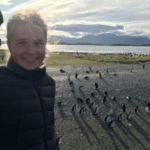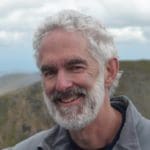
America Walks is proud to announce that 18 fellows from the 2022 National Walking College class are expected to successfully complete all requirements to graduate from the program.
What is the National Walking College Program?
The Walking College is a six-month, competitive fellowship designed to expand the capacity of local advocates to be effective community change agents. Topics include the history of our car-centric transportation networks and the role systemic racism has played in shaping those networks; design and policy to foster active transportation; and how to organize. Fellows work with other members of their class and an experienced mentor to develop the knowledge and skills needed to create community change. At the conclusion of the Walking College, fellows develop a Walking Action Plan to serve as a blueprint for their work going forward.
“We are thrilled to add another 18 fellows to our esteemed group of Walking College alumni now 180-strong who are putting their skills to use across the country in making meaningful change in their communities,” said Emilie Bahr, Walking College manager with America Walks. “These fellows were selected from a competitive group of applicants and have been valuable members of this year’s fellowship class. We are excited to see the yields of their hard work and their organizing and advocacy efforts translate to real change on the ground at a time when the importance of safe, accessible opportunities for moving around our communities outside of cars has never been more pronounced. We are certain that they will prove to be some of America Walks’ most valuable grassroots partners.

Below, we share short biographies of a selection of our recent graduates, along with the problem they have chosen to tackle as part of their end-of-term action plans:
Kellie Kirksey – Boardman, OH

Kellie Kirksey, PhD, is a licensed clinical counselor, rehabilitation counselor, and yoga instructor, specializing in mindfulness, holistic pain management, and integrated counseling and wellness based in Youngstown, Ohio. She is the founder of Creative Wellness Solutions, through which she offers health, wellness and stress-management coaching and non-traditional healing modalities.
Kellie’s action plan centers on developing meditative walking labyrinths in urban communities, starting in her community, which she envisions serving as sanctuaries and places for communal gathering and healing. She takes her inspiration from her experience growing up in what she describes as a violence-prone section of Cleveland. “I see Youngstown being a destination where people from all over the world visit to walk the city-wide constellation of labyrinths for peace and hope. The labyrinths will not only be a place for a meditative walk, but also a gathering space,” potentially used as farmer’s markets, yoga, book clubs, and more.
Kellie plans to start with a mobile, demonstration labyrinth as soon as this winter, offering indoor, temporary installations at local community centers and churches. In the spring, she plans to start fundraising toward her first permanent installation outside a church that she says has already identified space for the project.
Priya Patel – San Diego, CA

Priya was born and raised in Vadodara, India. After practicing as an architect in India for several years, she immigrated to the United States in 2016 to receive her dual master’s degrees in city planning and urban design from the University of Texas at Austin. She now works as an urban planner/designer for Black+Vernooy and serves on the boards of several community advocacy groups. She strives toward equity and justice in the worlds of transportation, planning, and design.
Priya’s action plan is rooted in her recent move from Austin, Texas, where she was well-connected to a group of like-minded individuals working to advance positive change, to San Diego, CA, where she does not yet have a robust network. Her action plan outlines ways in which she intends – and has already begun – to build partnerships, peers, and mentors and to identify opportunities for meaningful involvement in addressing the pressing mobility challenges confronting her new home.
Doris Bullock – Youngstown, OH

Doris is the supervisor of the Mercy Health Stepping Out program and is passionate about promoting health and wellness in her community. She credits her interest in walkability to the alarming rise in pedestrian fatalities in her home state of Ohio and walking for saving her from the ravages of diabetes.
Her action plan aims to promote walking and moving in the high-poverty Eastside community in Youngstown, OH. It calls for civic investment in new crosswalks, signage and lighting, and enhanced bicycle infrastructure, and the opening of an indoor facility for people to walk in the winter months.
Kristi King, PhD – Louisville, KY

Kristi is an associate professor in the Exercise Physiology and Community Health programs at University of Louisville in Louisville, Kentucky.
Her action plan calls for the development, implementation and institutionalization of interdisciplinary physical activity and public health courses into the curriculum at the University of Louisville and innovative partnerships with university colleagues, government officials, and community leaders to help the university become a leader in physical activity and public health teaching, research and service.
Anita Hollmann Matijcio – Houston, TX

Anita serves as Houston-Galveston Area Council’s (H-GAC) primary contact for the Livable Centers Program, a program that works with communities to help them identify policies and infrastructure that would make it easier for people to live, work, and play with less reliance on their cars. Her 10-year evaluation of the program is nationally-recognized and serves as the basis for most recent programmatic changes. Specifically, Anita’s interest lies in maturing planning-level recommendations for implementation through appropriate policies, programs, and community-appropriate projects. As a seasoned transportation planner, her work includes sub-regional mobility studies, roadway design reviews, bikeway design considerations, and most recently, land use.
Anita’s action plan calls for the incorporation of a walk audit framework as a component of the Livable Centers Program. To date, she says, the program has completed 38 studies and a walking-based program but has not included walk audits as part of its process.
Tammy VuPham – Redmond, WA

Tammy is a parks and trails commissioner for her city. She became involved with pedestrian access after caretaking for her multigenerational family. With her background in human-centered design and social psychology, Tammy is interested in improving community mobility and wellbeing through solutions in the built environment. Her goal is to incorporate nature spaces within the dynamic growth of her city. She also works as a backcountry guide in the Cascade mountains and is an outdoor recreation advocate.
Tammy’s action plan aims to leverage the city’s goal of reaching carbon neutrality by 2030 to shift commuting patterns in favor of non-car transport.
Andy Fry – Topeka, KS

Andy lives with his wife and two daughters in Central Topeka, one of the more walkable areas in the community, and works for the Topeka Metropolitan Transit Authority. His work and personal interest in making Topeka accessible to people riding bicycles brought him to realize the need for solid pedestrian facilities as a root of a healthy community. All of these modes depend on the ability to walk and move about one’s community on foot.
Andy’s action plan calls for the development of Walk-Bike Topeka, an advocacy organization to bring together existing individuals and groups working to promote active transportation in the city to develop a cohesive voice and strategy for making needed improvements.
Tyler Mitchell – Abilene, Texas

Tyler is a public health educator in Abilene, Texas. He pins his interest in pedestrian advocacy to his tenure as a volunteer with Meals on Wheels, when he took note of a lack of sidewalks in more economically-distressed parts of town. He set out during his fellowship to become a better advocate for accessible sidewalks in his community,
Tyler’s action plan focused on getting more students at a local elementary school to walk and bike to school.
Julia Mettler-Grove – Cleveland, Ohio

Julia lives in Cleveland, Ohio and was first introduced to pedestrian advocacy in college. She is interested in universal design as a means of preventing pedestrian deaths and increasing the safety for all on the road. As part of her Walking College experience, she was eager to learn about how to shift policy and create institutional change to support pedestrians, bicyclists, and public transit users while improving her organizing and strategizing skills.
Julia’s action plan calls for the creation of a wayfinding initiative in Cleveland to connect neighborhoods with surrounding greenways.
Steve Garon – Staunton, Virginia

Steve lives in Staunton, VA, in the Shenandoah Valley. He’s been an avid hiker, walker and bicyclist for about 40 years and became interested in pedestrian advocacy fairly recently through his membership on the Staunton Bicycle and Pedestrian Advisory Committee and his job as the Safe Routes to School (SRTS) Coordinator for Waynesboro, VA.
His action plan focuses on developing a coalition of partners to advocate for improvements to active transportation infrastructure in the Wenonah School District with an eye toward catalyzing change in the broader community.
Simon Bernnard – Philadelphia, Pennsylvania

Simon is a county planner with Pennsylvania’s Montgomery County Planning Commission. He lives in Philadelphia’s Manayunk neighborhood with his wife and two dogs having moved from Upstate New York for graduate school and to start their careers. Simon first became interested in pedestrian advocacy while living in Plattsburgh, NY. He lived a few miles from the nearest grocery store and the only way to get quality food was to drive or walk along a highly-trafficked road with intermittent sidewalks. Through the Walking College, he hoped to learn some technical skills related to designing streets for people and to hone his ability to advocate for behavior change.
Simon’s action plan envisions higher-quality active transportation infrastructure connecting residents of the Perkiomen Valley to schools and other everyday needs.